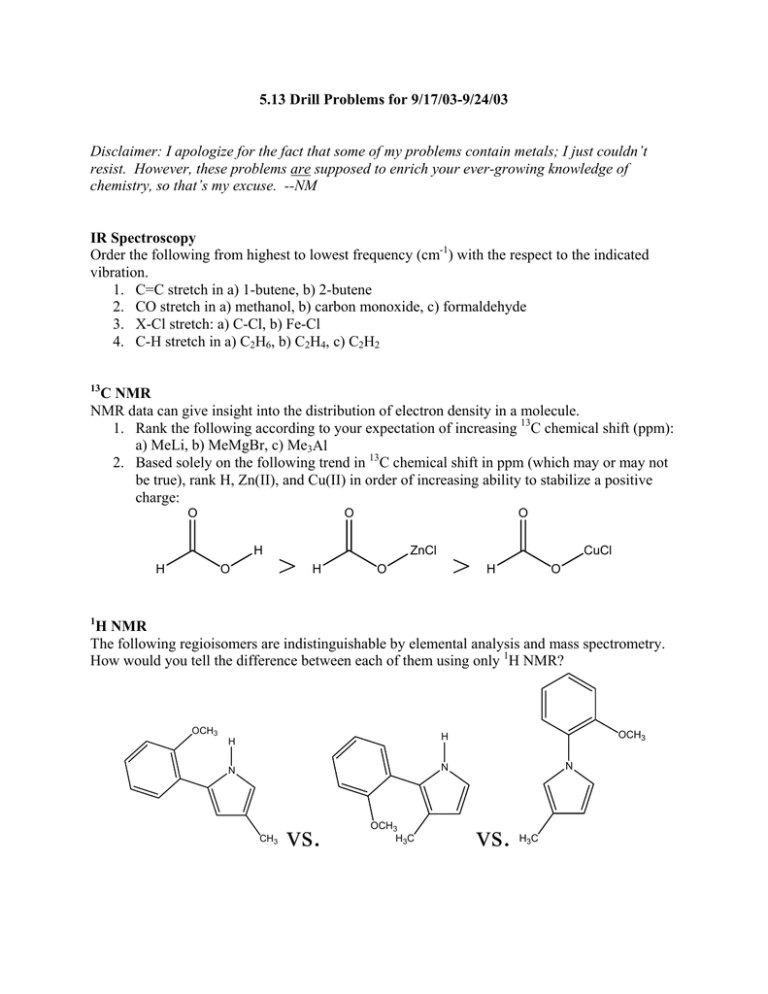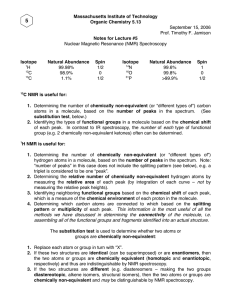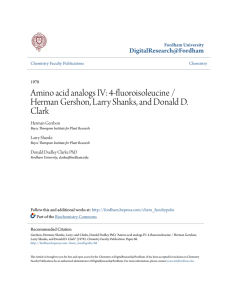5.13 Drill Problems for 9/17/03-9/24/03
advertisement

5.13 Drill Problems for 9/17/03-9/24/03 Disclaimer: I apologize for the fact that some of my problems contain metals; I just couldn’t resist. However, these problems are supposed to enrich your ever-growing knowledge of chemistry, so that’s my excuse. --NM IR Spectroscopy Order the following from highest to lowest frequency (cm-1) with the respect to the indicated vibration. 1. C=C stretch in a) 1-butene, b) 2-butene 2. CO stretch in a) methanol, b) carbon monoxide, c) formaldehyde 3. X-Cl stretch: a) C-Cl, b) Fe-Cl 4. C-H stretch in a) C2H6, b) C2H4, c) C2H2 13 C NMR NMR data can give insight into the distribution of electron density in a molecule. 1. Rank the following according to your expectation of increasing 13C chemical shift (ppm): a) MeLi, b) MeMgBr, c) Me3Al 2. Based solely on the following trend in 13C chemical shift in ppm (which may or may not be true), rank H, Zn(II), and Cu(II) in order of increasing ability to stabilize a positive charge: O O H O H > O ZnCl H > O CuCl H O 1 H NMR The following regioisomers are indistinguishable by elemental analysis and mass spectrometry. How would you tell the difference between each of them using only 1H NMR? OCH3 H H N N CH3 vs. OCH3 H3C OCH3 N vs. H3C Misc. NMR questions Transition metal complexes of Arduengo carbenes are becoming increasingly important in organometallic catalysis. Consider the following Arduengo carbene copper complex: CH3 Cu N N 1. The 1H NMR resonance for the copper-bound methyl group comes in at -0.491 ppm. In general, most alkyl resonances fall between 0 and 3 ppm. Qualitatively, why does this unusual methyl group exhibit a resonance with a chemical shift less than 0 ppm? 2. The 1H NMR resonances for the isopropyl groups are as follows: 1.11 ppm (doublet, 12H), 1.45 ppm (doublet, 12H), and 2.69 ppm (septet, 4H). Normally, the methyl groups in an isopropyl group are chemically equivalent, and so one only observes two resonances attributable to the isopropyl group. Why, in this case, are there three distinct isopropyl resonances? (I.e., why are all three carbons in each of the isopropyl groups chemically inequivalent from each other?) 3. Represent the above molecule as LCuCH3, and pretend that NMR is your only tool of characterization. Using 1H and 13C NMR, the above structure would be indistinguishable from the ion-paired structure [L2Cu]+[Cu(CH3)2]-. If 63Cu NMR were a viable method, how could you tell the difference between the ion-paired [L2Cu]+[Cu(CH3)2]- structure and the covalent LCuCH3 structure shown above?









